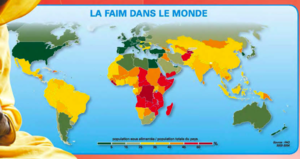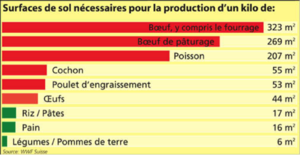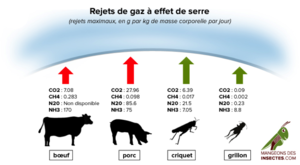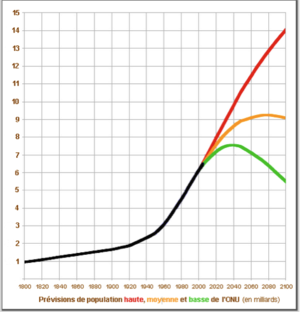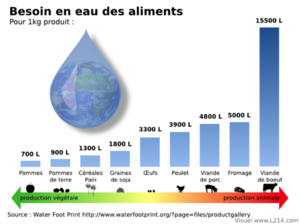First assignment of group n° 082
First description of our project[modifier | modifier le wikicode]
First description of our project's idea
Our project is based on the issue of malnutrition and on overuse of livestock. We plan to create a new type of food : food composed of insect or flour of insect. The aspect won’t be icky and it will provide all nutrition we need. The project is also to reduce bad perception of insects and predict to product locally.
Questions[modifier | modifier le wikicode]
What Problem do you want to solve?
The problem we want to solve is not unique. The project will contribute to improve some issues we identified. Indeed, the problem we first want to educate population about the impact of over-producing natural resources as industrial meats agriculture and malnutrition. But developing our project will affect other issues. The demographics forecast for 2050 estimate that we would be between 9 or 10 billion people.
Nowadays, with 7 million humans we face many macro-environment issues:
- • Malnutrition (over African continent, and Western Asia)
- • Environmental and health impacts of global meat production.
- • Overfishing of oceans
- • Water growing need
- • Global warming
- • Population’s increase is outstripping world’ s food production.
Why the problem exist ?[modifier | modifier le wikicode]
- Malnutrition:
According to World Food Program, 795M humans live without enough food to have a healthy life. (One of nine in people of the world). Not surprising, the vast majority are living in developing countries with 13,5% of undernourished people. This issue is mainly present in Sub Saharan Africa (highest rate of undernourished, 1 of 4). Malnutrition comes from sometime from political instability and unequal repartition of resources as Africa or overconsumption in USA. Indeed in those countries, malnutrition is present in junk food and in many industrial products. Malnutrition problems causes 45% of deaths in children under five years old with 3.1 children’ loss.
- Environmental and health impacts of global meat production:
World’s land is occupied by 40% for foods’ production and 30 % of it is used for meats’ production. Meats ‘production use 1/3 of world’s fresh water. (CSIORO, and International Institute for Applied Systems Analysis (IIASA). Each year, the livestock sector produces 256 million tons of meats altogether (59M tons of buffalo meat and 11M tons of sheep and goats.). 36 kilos of meats per person over the world if decided by the number of humans, but the main issues is this is not divided in an equal manner. For example, American people consume 122 kilos of meats per years. Moreover, this production required feeding animals with 1.3 billions ton of grains each years, resources not use to feed human. As comparison, Saharan Africa eat just 50 million tons of grain each year. In Europe or USA, a cow consumes about 75 to 300 kilos of grass or grain to production one kilo of protein. Despite French cows emitted as much CO2 in one year as 15million of cars. Moreover, lack of modernization in developing countries lead to the pollution of 1000kg of carbon for every kg of protein produce (10 times higher than in developed countries for less production). Finally, to create 1Kg of beef, 15 500L of water is needed. A quantity of water not use for human's hydration. This overproduction leads to health issue. Indeed, producers are now using antibiotics as prevention or for growing production. According to WTO, at least 50 % of antibiotics use worldwide is for animals. Because of promiscuity and low genetic diversity in industrial animal 's production, this massive consumption of antibiotics leads to the apparition of pathogenic diseases and resistance to antibiotics. This spread in the environment is produced by defection's animals, which contaminate lands and can be transmitted in insufficient cooking meats.
Most of gas’ emissions come from developing countries.
Here others issues we analysed which give the importance of financing our project:
- Overfishing:
Overfishing has been underlined since 1800s and have been getting worse years by years. National Geographic reports that « a study of catch data published in 2006 in the journal Science grimly predicted that fishing rates continue apace, all the world’s fisheries will have collapsed by the year 2048 ». It also exist farm fish but these king of fish farm use several toxic product as : antibiotics, pesticides, dioxin and heavy metal. More than 85% of fishing in the world have been pushed to its limited threatened many species with a direct impact on food supply chain. Illegal fishing does not get things better. It will have a direct impact also on human, one of five inhabitants are dependent of fish as protein resources. Price of fishes has been four times higher since a decade ago.
- Population’s increase is outstripping world’ s food production:
The demand of foods has increased of 70%, especially since Asia is becoming an important consumer of meats. At the same time, least developed countries needs to go through food's aid because it is now insufficient for feeding everyone. United Nations forecast for 2050, 9 to 10 billion inhabitants worldwide a number that won't stop to grow over the years. The demand for foods will be much higher than now even if we are already over-producing foods. Moreover, the extension of cities will take lands spaces required for the production of foods. Population's evolution will worst the others points highlighted. Humanity is living on credit since 1992 .The " overshoot day" is every year earlier. In the mid- 1990s, he fell in November. In 2000, it was on 1 October and today in 2015 it was on the 19 of august. It shows the urgency to change our way to consume.
- Water growing needs:
Nowadays, each person (in developed countries spend around 2 000 litter of water per days. According to the CNRS we use around 40 litters per days and per person for domestic consumption. To live, we use around 730 000 litter per year per inhabitant. Here an important data: there is 35 million km3 of freshwater lake but compose of 70% of ice and 30% in groundwater table. Freshwater only represent 3% of the whole water present on Earth.
- Global warming:
Global warming planet is already in process with the intensification of greenhouses' emissions, ground are getting more and more arid, there is melting of ices caps which leads to the step forward of oceans over seashores (half of the population is living within 60km sea, and three-quarters of all large cities are located on the coast. According to IPCC 2007 report, sea levels will rise by 7-23 inches by the end of this century due to global warming. In other part, as reporting by a number of climate studies, the 20th century's laso decades were the hottest in 400 years.
What breakthroughs are you committed to creating?[modifier | modifier le wikicode]
We plan to work on protein alternative. Use simple way to feed the global population with three different foundations:
- • Healthy
- • Biological
- • Universal
The product could be use by everybody in every country, from Europe to Africa. The principle is to make a low cost high quality food, product locally.
However, one of our objectives is to have a neutral look product in order to satisfy different culture. We plan to produce good locking food from insects, in order to sell them at low cost and to provide it all over the world.
We may not focus on use the insect’s food to make people far away from starvation but make people far away from malnutrition.
By doing good looking aspect to the food, we want to change the prejudice in eating insects. By doing this kind of food, it could resolve our main problem: malnutrition and additionally it could affect other issues as: overfishing of oceans, Water growing need, global warm population’s increases is outstripping world’ s food production.
Potential experts already identified'[modifier | modifier le wikicode]
Jean-manuel Bluet, Head of Sustainable development at Neslé
Elodie Veille- Blanchard, President of non lucrative organisation " Végétarienne de France"
